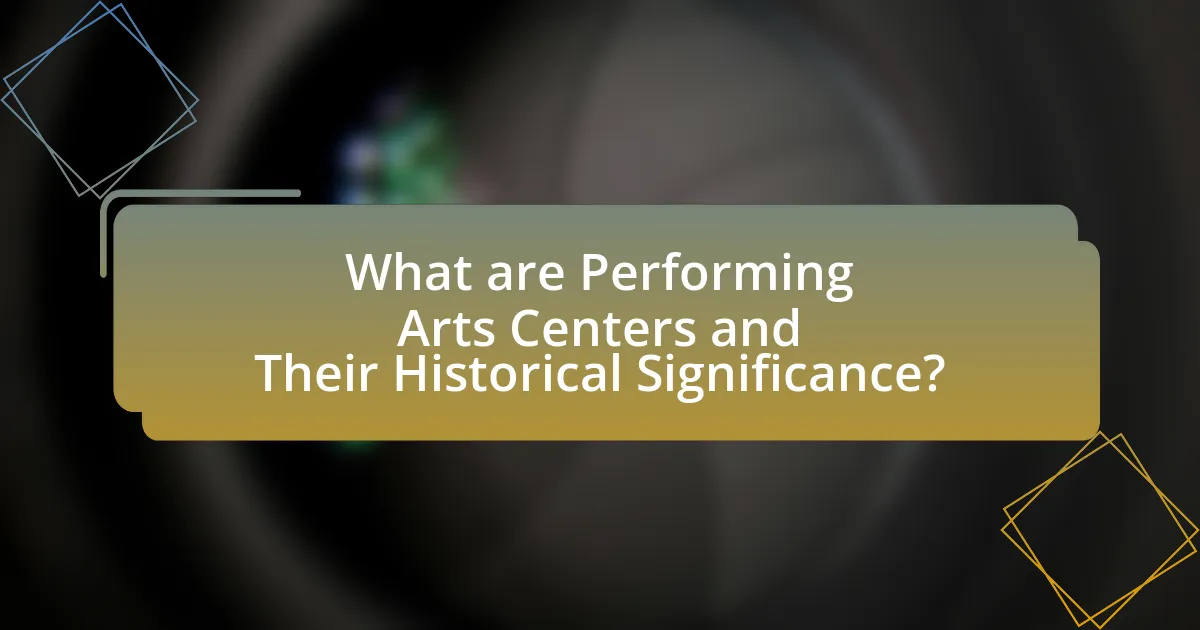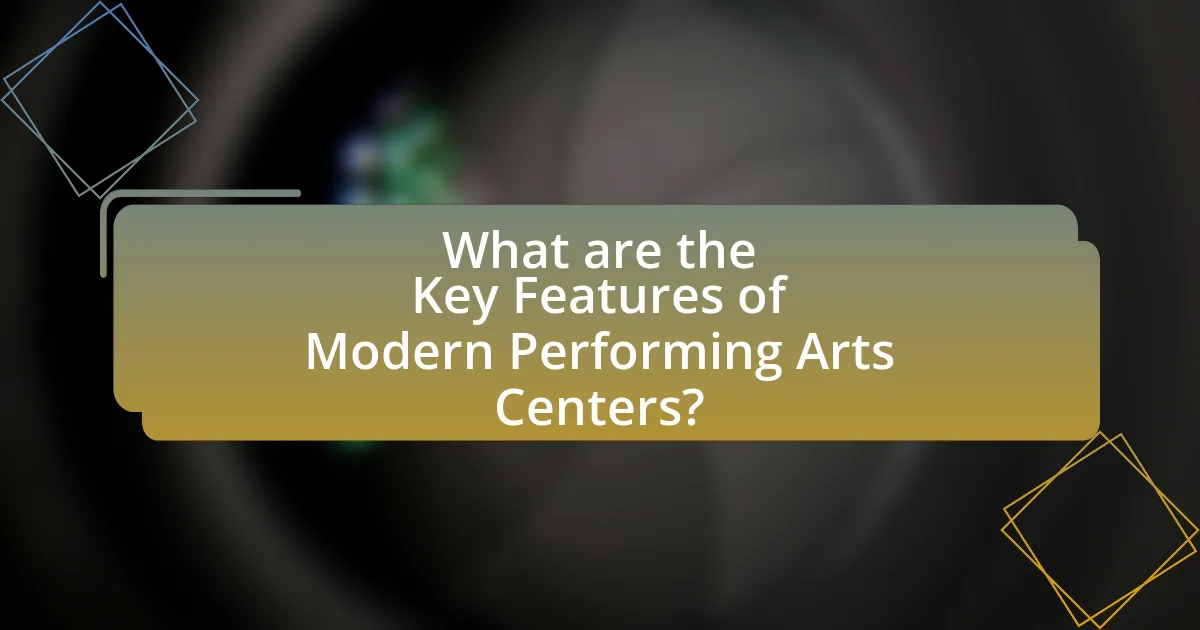Performing Arts Centers are specialized venues for live performances, encompassing theater, music, and dance, with historical significance rooted in the 20th century. This article explores their evolution from traditional venues to modern spaces, highlighting advancements in technology, design, and community engagement. Key topics include the characteristics of traditional venues, the impact of cultural shifts on design, the role of these centers in fostering local talent and economic growth, and the challenges they face in a digital age. Additionally, it discusses best practices for enhancing success through community partnerships and innovative programming strategies.

What are Performing Arts Centers and Their Historical Significance?
Performing Arts Centers are dedicated venues designed for the presentation of various forms of live performances, including theater, music, dance, and other artistic expressions. Historically, these centers emerged in the 20th century as a response to the growing demand for specialized spaces that could accommodate large audiences and provide advanced technical facilities for artists. The establishment of iconic venues, such as the Lincoln Center for the Performing Arts in New York City in 1962, exemplifies their significance in promoting cultural engagement and accessibility to the arts. These centers have played a crucial role in the evolution of performing arts by fostering community involvement, supporting local artists, and serving as cultural hubs that reflect societal values and artistic trends over time.
How have Performing Arts Centers evolved over time?
Performing Arts Centers have evolved significantly from traditional venues to modern spaces that cater to diverse artistic expressions and community needs. Initially, these centers were primarily designed for specific types of performances, such as theater or classical music, often reflecting the architectural styles and cultural values of their time. Over the decades, the introduction of advanced technology, such as sound and lighting systems, has transformed these venues into multifunctional spaces capable of hosting a variety of events, including concerts, dance performances, and community gatherings.
For instance, the opening of the Sydney Opera House in 1973 marked a pivotal moment in architectural design and functionality, showcasing how performing arts centers could serve as iconic cultural landmarks while accommodating various performance types. Additionally, the rise of digital media and streaming has prompted many centers to incorporate virtual components, expanding their reach beyond physical audiences. This evolution reflects a broader trend towards inclusivity and accessibility in the arts, as seen in initiatives like the National Endowment for the Arts’ support for community engagement programs.
What were the characteristics of traditional performing arts venues?
Traditional performing arts venues were characterized by their intimate settings, architectural significance, and cultural symbolism. These venues often featured proscenium stages, which provided a clear separation between performers and the audience, enhancing the theatrical experience. Additionally, traditional venues typically included ornate designs, reflecting the artistic values of the time, and were often located in central community areas, making them accessible to the public. Historical examples, such as the Globe Theatre in London, illustrate these characteristics, showcasing how architecture and location played crucial roles in the cultural landscape of performing arts.
How did cultural shifts influence the design of these venues?
Cultural shifts significantly influenced the design of performing arts venues by prioritizing inclusivity, technology integration, and community engagement. For instance, the rise of diverse artistic expressions led to the incorporation of flexible spaces that accommodate various performance styles, reflecting the multicultural landscape of contemporary society. Additionally, advancements in technology prompted the design of venues with enhanced acoustics and visual capabilities, allowing for immersive experiences that cater to modern audiences. Historical examples include the transformation of traditional proscenium theaters into adaptable spaces like the Sydney Opera House, which embraces both architectural innovation and cultural diversity, demonstrating how evolving societal values shape venue design.
What role do Performing Arts Centers play in community engagement?
Performing Arts Centers serve as vital hubs for community engagement by providing accessible spaces for cultural expression, education, and social interaction. These centers host a variety of events, including performances, workshops, and community gatherings, which foster a sense of belonging and encourage participation from diverse groups. Research indicates that communities with active performing arts venues experience increased social cohesion and civic involvement, as these centers often collaborate with local organizations to address community needs and promote inclusivity. For example, a study by the National Endowment for the Arts found that participation in arts activities can lead to higher levels of community engagement and volunteerism, demonstrating the significant impact of Performing Arts Centers on local social dynamics.
How do these centers foster local talent and creativity?
Performing arts centers foster local talent and creativity by providing accessible spaces for artists to showcase their work and engage with the community. These centers often host workshops, training programs, and mentorship opportunities that empower local artists to develop their skills. For instance, many performing arts centers collaborate with local schools and organizations to offer educational programs that nurture young talent, thereby creating a pipeline for future artists. Additionally, these venues frequently feature local productions and events, which not only promote regional talent but also encourage community participation and support for the arts. This approach has been shown to enhance cultural vibrancy and economic growth within the community, as evidenced by studies indicating that arts engagement can lead to increased local spending and tourism.
What impact do they have on local economies?
Performing arts centers significantly boost local economies by generating revenue through ticket sales, tourism, and job creation. For instance, a study by the National Endowment for the Arts found that every dollar spent on the arts generates approximately $4 in economic activity. This includes increased spending in nearby restaurants, hotels, and retail stores, as visitors attend performances. Additionally, these centers create jobs not only within the arts sector but also in supporting industries, contributing to overall economic growth in the community.

What are the Key Features of Modern Performing Arts Centers?
Modern performing arts centers are characterized by versatile spaces, advanced technology, and community engagement. These centers typically feature adaptable performance venues that can accommodate various types of events, such as theater, dance, and concerts, allowing for a wide range of artistic expressions. Advanced sound and lighting systems are integral, enhancing the audience experience and supporting diverse productions. Additionally, modern centers often include educational facilities and community spaces, fostering local involvement and outreach programs. According to the National Endowment for the Arts, these features not only improve the quality of performances but also increase accessibility and participation in the arts, reflecting a shift towards inclusivity and innovation in cultural spaces.
How do modern designs differ from traditional venues?
Modern designs differ from traditional venues primarily in their emphasis on flexibility, technology integration, and audience engagement. Traditional venues often feature fixed seating and rigid layouts, while modern designs prioritize adaptable spaces that can accommodate various performances and events. For instance, modern performing arts centers frequently incorporate advanced sound and lighting systems, allowing for enhanced production quality and immersive experiences. Additionally, modern venues often include open floor plans and multifunctional areas that encourage interaction among audiences, contrasting with the more formal and segmented arrangements typical of traditional venues. This shift reflects a broader trend towards creating inclusive and dynamic environments that cater to diverse artistic expressions and audience preferences.
What technological advancements are incorporated into modern spaces?
Modern spaces incorporate advancements such as digital sound systems, advanced lighting technology, and interactive multimedia displays. Digital sound systems enhance audio quality and clarity, allowing for immersive experiences in performances. Advanced lighting technology, including LED and intelligent lighting, enables dynamic visual effects that can be tailored to specific performances. Interactive multimedia displays, often integrated into stage design, allow for real-time audience engagement and enhance storytelling through visual elements. These technologies collectively transform the audience experience and improve the functionality of performing arts centers.
How do modern centers enhance audience experience?
Modern centers enhance audience experience through advanced technology, improved acoustics, and flexible seating arrangements. These venues utilize state-of-the-art sound systems and visual displays to create immersive environments, ensuring that every audience member can enjoy high-quality performances. For instance, the integration of digital ticketing and mobile apps streamlines access and enhances convenience, allowing for a more seamless experience. Additionally, modern centers often feature amenities such as comfortable seating, enhanced accessibility options, and diverse food and beverage offerings, which contribute to a more enjoyable visit. Research indicates that venues with upgraded facilities and technology report higher audience satisfaction ratings, demonstrating the effectiveness of these enhancements in enriching the overall experience.
What types of performances are hosted in contemporary centers?
Contemporary centers host a variety of performances, including theater productions, dance performances, music concerts, and multimedia art shows. These venues are designed to accommodate diverse artistic expressions, reflecting the evolution of performing arts from traditional formats to innovative presentations. For instance, many contemporary centers feature flexible staging and advanced technology, allowing for immersive experiences that blend different art forms, such as live music with visual projections. This adaptability supports a wide range of performances, catering to various audiences and artistic styles.
How do these venues accommodate diverse art forms?
Venues accommodate diverse art forms by incorporating flexible performance spaces, advanced technology, and varied programming. Flexible performance spaces, such as adjustable stages and modular seating, allow venues to host everything from theater productions to dance performances and concerts. Advanced technology, including sound and lighting systems, enhances the presentation of different art forms, ensuring that each can be experienced optimally. Additionally, varied programming schedules that include visual arts exhibitions, film screenings, and community events further support the inclusion of multiple art forms, catering to a wide audience and fostering artistic diversity.
What are the benefits of multi-purpose spaces in modern centers?
Multi-purpose spaces in modern centers enhance flexibility, allowing venues to host a variety of events, from performances to community gatherings. This adaptability maximizes usage and revenue potential, as spaces can be reconfigured for different functions, accommodating diverse audiences and activities. For instance, a study by the National Endowment for the Arts highlights that multi-purpose venues can increase attendance by up to 30% due to their ability to cater to various interests and demographics. Additionally, these spaces foster community engagement by providing a platform for local artists and organizations, thereby strengthening cultural ties and promoting inclusivity.

What Challenges Do Performing Arts Centers Face Today?
Performing arts centers today face significant challenges including financial sustainability, audience engagement, and adapting to technological advancements. Financial sustainability is a pressing issue, as many centers rely on ticket sales, donations, and grants, which can fluctuate due to economic conditions; for instance, a 2021 report indicated that 63% of arts organizations experienced a decline in revenue due to the pandemic. Audience engagement has also become increasingly complex, as centers must compete with digital entertainment options and changing consumer preferences, leading to a need for innovative programming and marketing strategies. Additionally, adapting to technological advancements is crucial, as centers must invest in new technologies for performances and audience experiences, which can strain limited budgets. These challenges collectively impact the operational viability and cultural relevance of performing arts centers in the modern landscape.
How do funding and financial sustainability impact these centers?
Funding and financial sustainability significantly impact performing arts centers by determining their operational capacity and programming diversity. Adequate funding allows these centers to maintain facilities, attract talent, and offer a wide range of performances, which in turn enhances community engagement and audience attendance. For instance, a study by the National Endowment for the Arts found that organizations with stable funding sources are more likely to present innovative programming and reach diverse audiences, thereby increasing their relevance in the cultural landscape. Conversely, financial instability can lead to reduced programming, staff layoffs, and even closure, as evidenced by the decline of several arts organizations during economic downturns. Thus, the financial health of performing arts centers directly influences their ability to thrive and adapt in a changing cultural environment.
What strategies are being implemented to secure funding?
Performing arts centers are implementing diverse strategies to secure funding, including public-private partnerships, grant applications, and community engagement initiatives. Public-private partnerships leverage resources and expertise from both sectors, enhancing financial stability and operational efficiency. Grant applications target specific projects or operational needs, with organizations often receiving funding from arts councils, foundations, and government entities. Community engagement initiatives foster local support and investment, encouraging donations and sponsorships from individuals and businesses. These strategies collectively enhance the financial viability of performing arts centers, ensuring their sustainability and growth in a competitive cultural landscape.
How do economic downturns affect attendance and programming?
Economic downturns significantly reduce attendance and alter programming at performing arts centers. During financial crises, individuals and families often cut discretionary spending, leading to decreased ticket sales and lower audience turnout. For instance, the 2008 financial crisis resulted in a 20% drop in attendance for many cultural institutions, as reported by the National Endowment for the Arts. Additionally, programming may shift to accommodate tighter budgets, with venues opting for lower-cost productions or community-focused events to attract local audiences. This adaptation reflects the need to maintain engagement while navigating financial constraints.
What are the challenges of maintaining relevance in a digital age?
Maintaining relevance in a digital age presents challenges such as adapting to rapidly changing technology, competing with diverse entertainment options, and meeting evolving audience expectations. Performing arts centers must continuously innovate their programming and marketing strategies to engage audiences who have access to a plethora of digital content. For instance, a 2021 survey by the National Endowment for the Arts indicated that 70% of adults reported consuming arts and culture through digital platforms, highlighting the necessity for traditional venues to integrate digital experiences. Additionally, the need for inclusivity and accessibility in performances has become paramount, as audiences increasingly demand representation and engagement that reflects their diverse backgrounds.
How are Performing Arts Centers adapting to changing audience preferences?
Performing Arts Centers are adapting to changing audience preferences by incorporating technology, diversifying programming, and enhancing accessibility. For instance, many centers now offer virtual performances and hybrid events, allowing audiences to engage from home or in-person, which caters to varying comfort levels post-pandemic. Additionally, they are programming a wider range of genres, including contemporary works and community-driven projects, to attract diverse demographics. According to a 2022 survey by the National Endowment for the Arts, 60% of arts organizations reported an increase in audience interest in digital content, highlighting the importance of these adaptations. Furthermore, initiatives to improve physical accessibility and create inclusive environments are being prioritized, ensuring that all community members can participate in the arts.
What role does digital technology play in the future of these venues?
Digital technology will play a transformative role in the future of performing arts venues by enhancing audience engagement and operational efficiency. For instance, the integration of virtual reality and augmented reality can create immersive experiences that attract diverse audiences, as evidenced by the use of VR in productions like “The Lion King” to enhance storytelling. Additionally, data analytics will enable venues to tailor programming and marketing strategies based on audience preferences, leading to increased attendance and revenue. A report by the National Endowment for the Arts highlights that venues adopting digital ticketing and streaming services have seen a 30% increase in audience reach, demonstrating the significant impact of digital technology on the sustainability and growth of performing arts centers.
What Best Practices Can Enhance the Success of Performing Arts Centers?
Best practices that can enhance the success of performing arts centers include community engagement, diverse programming, effective marketing strategies, and strong financial management. Community engagement fosters a loyal audience base, as seen in the success of venues that actively involve local residents in decision-making and programming. Diverse programming attracts a wider audience, with research indicating that centers offering a variety of performances, from classical to contemporary, see increased attendance. Effective marketing strategies, including social media outreach and targeted advertising, have proven to boost ticket sales and visibility, as evidenced by case studies of successful arts organizations. Lastly, strong financial management ensures sustainability, with centers that implement sound budgeting practices and seek multiple revenue streams, such as grants and sponsorships, demonstrating greater resilience in fluctuating economic conditions.
How can community partnerships strengthen these centers?
Community partnerships can strengthen performing arts centers by enhancing resource sharing and increasing audience engagement. Collaborations with local businesses, schools, and cultural organizations provide financial support, in-kind donations, and volunteer efforts, which can improve programming and facilities. For instance, a partnership with a local school can lead to educational workshops and performances that attract students and families, thereby expanding the center’s audience base. Additionally, research indicates that community involvement in arts initiatives can lead to a 30% increase in attendance and participation, demonstrating the tangible benefits of such partnerships.
What innovative programming strategies can attract diverse audiences?
Innovative programming strategies that can attract diverse audiences include the incorporation of community-driven events, interdisciplinary collaborations, and the use of technology to enhance accessibility. Community-driven events, such as local artist showcases or cultural festivals, foster a sense of belonging and encourage participation from various demographic groups. Interdisciplinary collaborations, like combining theater with visual arts or music, appeal to a broader audience by offering multifaceted experiences. Additionally, leveraging technology, such as virtual reality or live streaming, can make performances accessible to those unable to attend in person, thus expanding reach. Research indicates that venues implementing these strategies have seen increased attendance and engagement from diverse populations, highlighting their effectiveness in attracting varied audiences.


